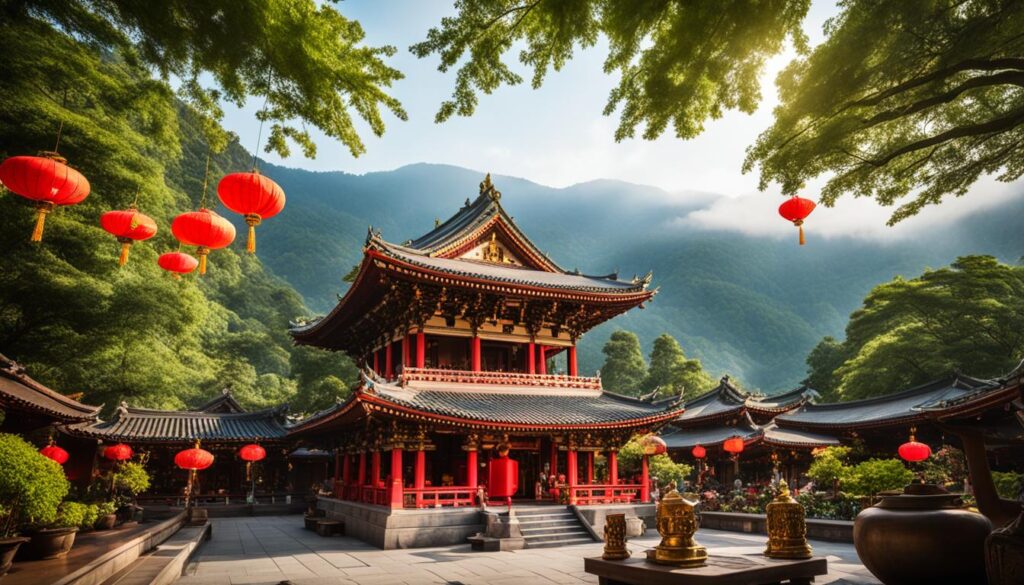Have you ever wondered about the ancient traditions and spiritual practices that have shaped Vietnamese culture for centuries? What if there was a path to inner peace and societal harmony that transcends time and borders? Explore the world of Buddhism in Vietnam, where history, culture, and spirituality intertwine to create a transformative journey of peace.
Key Takeaways:
- Discover the rich history of Buddhism in Vietnam, dating back to the 2nd century BCE.
- Explore the different forms of Vietnamese Buddhism, including Zen Buddhism, Pure Land Buddhism, and Vajrayana.
- Visit Buddhist temples and pagodas, experiencing the tranquility and beauty of these sacred spaces.
- Engage with Buddhist monks and nuns, gaining insights into their practices and way of life.
- Immerse yourself in Vietnamese Buddhist traditions, from meditation and prayer to acts of devotion and ceremonies.
Buddhism’s Impact on Personal and Societal Harmony
Buddhism offers profound teachings that have a transformative impact on personal and societal harmony in the modern world. By integrating mindfulness and compassion into our lives, we can navigate the challenges of contemporary society with grace and find inner peace.
The practice of mindfulness, an essential aspect of Buddhist teachings, invites us to be fully present in the here and now. It cultivates awareness of our thoughts, emotions, and actions, allowing us to engage with life’s experiences in a more conscious and meaningful way. Through mindfulness, we develop a deeper understanding of ourselves, leading to personal growth and harmony.
Compassion, another cornerstone of Buddhism, encourages us to extend kindness, empathy, and understanding not only to ourselves but also to others. In today’s fast-paced and interconnected world, practicing compassion becomes crucial as it helps foster healthy relationships, build bridges across differences, and create a more harmonious society.
Incorporating mindfulness and compassion:
- Cultivating mindfulness in our daily activities helps us stay present and fully engaged in our interactions, enhancing the quality of our relationships.
- Practicing self-compassion allows us to embrace our imperfections with kindness and helps us approach challenges with resilience and a sense of inner peace.
- Expressing compassion towards others through acts of generosity, empathy, and active listening fosters harmony and understanding within our communities.
- Embracing forgiveness and letting go of anger and resentment creates space for healing and reconciliation, leading to harmonious connections and collective growth.
By integrating mindfulness and compassion into our daily lives, we can navigate the modern challenges with greater wisdom and grace, enhancing personal well-being and contributing to a more harmonious society.

| Benefits of Mindfulness and Compassion | Personal Harmony | Societal Harmony |
|---|---|---|
| Enhanced self-awareness and emotional intelligence | Promotes inner peace and well-being | Fosters empathy and understanding |
| Reduced stress, anxiety, and depression | Improves relationships and communication | Strengthens social cohesion and harmony |
| Improved focus, concentration, and cognitive abilities | Nurtures self-compassion and self-acceptance | Encourages collective responsibility and cooperation |
| Greater resilience and adaptability in the face of challenges | Cultivates forgiveness and compassion towards oneself | Promotes peace-building and conflict resolution |
History of Buddhism in Vietnam
Discover the ancient origins and enduring influence of Buddhism in Vietnam.
Buddhism holds a significant place in the cultural and spiritual heritage of Vietnam, with a history that dates back to the 2nd century BCE. It is one of the oldest religions in the country, and its influence has shaped the spiritual and social fabric of the nation.
Under the Nguyen Dynasty in the 11th century, Buddhism gained prominence and became the official religion of Vietnam. Buddhist monks and nuns played a central role in spreading the teachings of Buddhism and establishing temples and pagodas throughout the country.
Over the centuries, Vietnamese Buddhist practices evolved, incorporating elements of Taoism and Confucianism. This fusion of philosophies created a unique synthesis in Vietnamese Buddhism, which is deeply interwoven with the cultural traditions of the country.
Buddhism in Vietnam is not just a religious belief but also a way of life. It encompasses a wide range of practices, including meditation, chanting, and acts of devotion. Vietnamese people embrace Buddhism and integrate its teachings into their daily lives, seeking inner peace and harmony.
Today, Buddhist temples and pagodas can be found scattered across Vietnam, serving as places of worship and spiritual refuge. They are not only architectural marvels but also an integral part of Vietnamese culture, symbolizing the deep connection between the people and their spiritual beliefs.
In the next section, explore the serene beauty of Buddhist temples in Vietnam and learn about the rich traditions and customs associated with these sacred sites.
Buddhist Temples in Vietnam
Vietnam is a land blessed with a multitude of Buddhist temples, each embodying its unique architectural style and spiritual significance. These temples stand as sacred havens, providing tranquil spaces for devotion, meditation, and the preservation of Vietnam’s rich cultural heritage.
One iconic temple is the One Pillar Pagoda located in Hanoi. Built in the early 11th century, this architectural masterpiece stands on a single stone pillar in the midst of a serene pond. Its unique design symbolizes the lotus flower emerging from the water, representing purity and enlightenment.

Venturing further, Bai Dinh Temple in Ninh Binh province captivates visitors with its grandeur. As the largest Buddhist temple complex in Vietnam, it spans an impressive area of over 700 hectares. Here, you can immerse yourself in the awe-inspiring beauty of ancient Vietnamese architecture while soaking up the ambiance of spiritual devotion.
Another gem awaits in beautiful Hue, where the Thien Mu Pagoda stands tall on the banks of the Perfume River. This seven-tiered pagoda is a symbol of the city and offers panoramic views of the surrounding landscape. Its peaceful atmosphere and intricate design make it a must-visit destination for those seeking spiritual solace.
When visiting these revered places, it is essential to honor the customs and traditions upheld by Buddhist temple etiquette in Vietnam. Respectful attire, such as covering shoulders and knees, is expected, and it’s customary to remove shoes and hats before entering the sacred spaces. Observing proper decorum, such as refraining from taking photos during prayers and meditation, allows for a harmonious coexistence of visitors and the spiritual practices.
Buddhist Temples in Vietnam
| Temple | Location |
|---|---|
| One Pillar Pagoda | Hanoi |
| Bai Dinh Temple | Ninh Binh |
| Thien Mu Pagoda | Hue |
Buddhist Monks in Vietnam
Buddhist monks hold a revered position in Vietnamese society, admired and revered by the community for their commitment to the teachings and practice of Buddhism. They dedicate their lives to studying and following the path of enlightenment, serving as spiritual guides and teachers for those seeking wisdom and guidance.
Monks in Vietnam reside in Buddhist monasteries, which provide them with a serene and disciplined environment conducive to their spiritual journey. Living a celibate and ascetic life, monks focus on meditation and self-reflection to cultivate inner peace and harmony.
Each day, monks engage in a series of rituals and practices that center around prayer, meditation, and contemplation. These daily activities form the foundation for their personal spiritual growth and allow them to deepen their understanding of Buddhist teachings.
In addition to their personal pursuits, Buddhist monks in Vietnam actively participate in various ceremonies, both within their monasteries and in the community. They perform rites and rituals to bless individuals, homes, and businesses, bringing positive energy and blessings to those in need.
Beyond their spiritual duties, monks also carry out charitable acts and engage in community service. They provide support and assistance to the less fortunate, promoting compassion and kindness in their interactions with others.
The presence of Buddhist monks in Vietnamese society is instrumental in preserving and transmitting the country’s rich Buddhist traditions. Through their teachings, guidance, and exemplary way of life, they inspire others to embrace the values of Buddhism and contribute to a harmonious and compassionate society.
By becoming acquainted with Vietnamese Buddhist monks and their practices, visitors to Vietnam can gain a profound appreciation for the dedication, discipline, and spiritual wisdom that permeates their way of life. Interacting with the monks, attending their ceremonies, and witnessing their devotion allows for a transformative experience that nurtures the soul and deepens one’s understanding of Vietnam’s Buddhist heritage.
Role of Buddhist Monks in Vietnamese Society
Centuries of tradition and reverence have shaped the role of Buddhist monks in Vietnamese society. They are considered pillars of wisdom and enlightenment, offering guidance, solace, and spiritual support to individuals and the community as a whole. The influence of monks extends beyond religious matters, as they also serve as mentors and counselors, respected for their moral integrity and compassion.
Vietnamese Buddhist Practices and Traditions
Vietnamese Buddhist practices are deeply intertwined with the cultural fabric of the country. The Vietnamese people embrace Buddhism and incorporate its teachings into their daily lives. They find solace and guidance in the principles of this ancient tradition, seeking inner peace and harmony.
Praying is an essential part of Vietnamese Buddhist practices. It is a way to express gratitude and connect with the divine. Buddhists in Vietnam often visit temples and pagodas to offer their prayers and seek blessings. The act of prayer provides a sense of comfort and spiritual nourishment, allowing individuals to deepen their connection with the divine.
Meditation is another key practice in Vietnamese Buddhism. By engaging in quiet contemplation, individuals cultivate mindfulness and gain clarity of mind. Meditation helps practitioners develop self-awareness, reduce stress, and find inner peace. It is a powerful tool for self-discovery and self-transformation.

Acts of devotion are a common sight in Vietnamese Buddhist culture. Buddhists often make offerings at home altars or temple altars as a way to show respect and gratitude. Offerings typically include flowers, fruits, and incense. These symbolic gestures represent the believers’ reverence for the teachings of Buddhism and their gratitude for the blessings received.
Vietnamese Buddhist traditions also encompass various ceremonies and rituals that are an integral part of the cultural heritage. For example, birth and marriage ceremonies often incorporate Buddhist blessings to seek protection and prosperity for the individuals involved. Funerals, on the other hand, follow specific Buddhist rituals to ensure a peaceful transition for the deceased.
Vietnamese Buddhist Practices and Traditions
| Practice | Description |
|---|---|
| Prayer | Expressing gratitude and seeking blessings. |
| Meditation | Cultivating mindfulness and finding inner peace. |
| Offerings | Symbolic gestures of respect and gratitude. |
| Ceremonies and Rituals | Marking important life events with Buddhist traditions. |
These practices and traditions reflect the deep spirituality and reverence for Buddhist teachings within Vietnamese culture. They provide individuals with a means to connect with higher consciousness, promote peace and harmony within themselves, and foster a sense of belonging to a larger community. Vietnamese Buddhist practices and traditions continue to shape the spiritual landscape of the country, inspiring generations to seek wisdom, compassion, and inner transformation.
Immersive Experiences of Buddhism in Vietnam
When you travel to Vietnam, you have the incredible opportunity to immerse yourself in the practices and traditions of Buddhism. Explore the profound spirituality and gain a deeper understanding of this ancient tradition by engaging in immersive experiences that take you to Buddhist temples and pagodas.
Visiting Buddhist temples and pagodas allows you to witness the serene beauty and architectural marvels of these sacred sites. You can marvel at the intricate designs and experience the tranquil atmosphere that permeates these places of worship. The One Pillar Pagoda in Hanoi, the Bai Dinh Temple in Ninh Binh province, and the Thien Mu Pagoda in Hue are just a few examples of the diverse Buddhist temples you can explore in Vietnam.
Participating in meditation sessions provides a unique opportunity to cultivate mindfulness and inner peace. You can learn mindfulness techniques directly from experienced practitioners and monks, allowing you to deepen your understanding of Vietnamese Buddhist practices. Through meditation, you can cultivate a sense of calm, clarity, and self-awareness.
Interacting with Buddhist monks and nuns offers a chance to gain insights into their way of life and the principles that guide them. Engaging in conversations and learning from their wisdom can provide a profound spiritual and cultural exchange. They can offer guidance on how to live a more mindful and compassionate life and share their perspectives on the values, customs, and beliefs that underpin Buddhism in Vietnam.

Wandering through the halls of the temples, participating in rituals and ceremonies, and connecting with the vibrant energy of the Buddhist community imparts a profound sense of peace and spirituality. These immersive experiences allow you to truly embrace the essence of Buddhism in Vietnam and gain a deeper appreciation for the role it plays in the lives of the Vietnamese people.
Insightful Travel Tips:
- Research specific temples or pagodas you wish to visit and learn about their historical and cultural significance beforehand.
- Dress respectfully when visiting temples, ensuring your shoulders and knees are covered. Removing your shoes before entering is also customary.
- Observe and respect the customs and practices of the Buddhist community, such as refraining from touching or taking photos during prayer or meditation sessions.
- Engage in conversations with monks and nuns, inquire about their insight and experiences, and be open to learning from their wisdom.
- Take the time to enjoy the peaceful ambiance of the temples, savor the tranquility, and reflect on the profound teachings of Buddhism.
Immersing yourself in Buddhism in Vietnam is a transformative journey that brings you closer to the country’s spiritual and cultural heritage. By experiencing firsthand the rituals, practices, and traditions, you gain a deeper appreciation for the values of mindfulness, compassion, and inner harmony. Engaging with this ancient and enduring tradition in Vietnam is an opportunity to cultivate a sense of peace and spirituality that resonates long after your journey is complete.
Conclusion
Buddhism in Vietnam is a captivating journey that unveils the country’s cultural and spiritual heritage. With a history dating back centuries, it has become deeply rooted in Vietnamese culture, encompassing diverse practices and traditions that continue to inspire and resonate with people from all walks of life.
Immersing yourself in Buddhism in Vietnam opens doors to a deeper understanding of this ancient tradition. Visiting Buddhist temples and pagodas allows you to witness the beauty of the architecture, engage in meditation sessions, and witness the rituals and ceremonies that shape Vietnamese Buddhist practices.
Engaging with Buddhist monks and nuns provides unique insights into their way of life and their dedication to the pursuit of enlightenment. Their teachings, along with the principles of mindfulness and compassion, promote personal and societal harmony, offering valuable lessons in navigating the modern challenges of life.
Embarking on the exploration of Buddhism in Vietnam is a transformative experience that enriches the soul and fosters a sense of inner peace and harmony. It is an opportunity to connect with the wisdom of the past, embrace the present, and carry forth the teachings of Buddhism into the future.
FAQ
What is the history of Buddhism in Vietnam?
Buddhism in Vietnam has a rich history, dating back to the 2nd century BCE. It became widely accepted and recognized as the official religion during the Nguyen Dynasty in the 11th century.
What are the major forms of Mahayana Buddhism practiced in Vietnam?
Vietnamese Buddhism encompasses three major forms of Mahayana Buddhism: Zen Buddhism, Pure Land Buddhism, and Vajrayana.
What role do Buddhist temples and pagodas play in Vietnamese culture?
Buddhist temples and pagodas serve as places of worship, meditation, and cultural preservation in Vietnamese culture.
How do Vietnamese Buddhist practices incorporate elements of Taoism and Confucianism?
Vietnamese Buddhist practices have evolved over time and incorporate elements of Taoism and Confucianism, which have had significant influence on Vietnamese culture.
What is the significance of Buddhist monks in Vietnamese society?
Buddhist monks hold a vital role in Vietnamese society, serving as spiritual guides and teachers and contributing to the preservation and transmission of Buddhist traditions.
What are some well-known Buddhist temples in Vietnam?
Some well-known Buddhist temples in Vietnam include the One Pillar Pagoda in Hanoi, Bai Dinh Temple in Ninh Binh province, and Thien Mu Pagoda in Hue.
What are some common Vietnamese Buddhist practices and traditions?
Common Vietnamese Buddhist practices include praying, meditation, acts of devotion, and ceremonies to mark important life events such as births, marriages, and funerals.
How can travelers engage in immersive experiences of Buddhism in Vietnam?
Travelers can visit Buddhist temples and pagodas, participate in meditation sessions, and interact with monks and nuns to gain a deeper understanding of Vietnamese Buddhist practices and traditions.

